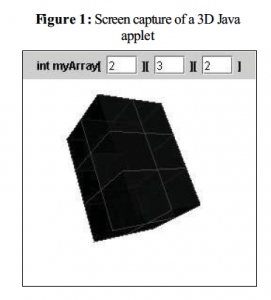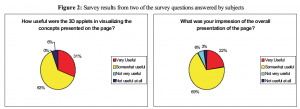Robert Franklin and Dr. Robert Burton, Computer Science
The advent and subsequent widespread use of the Internet have facilitated and motivated hypermedia distance learning. Unfortunately, graphic images used in support of Internet-based distance learning usually are non-interactive and two-dimensional because computers have traditionally not been fast enough to perform the myriad of calculations needed to render 3D graphics and accommodate interaction. Modern high-speed computer processors have made interactive three-dimensional graphics common. However, the potential of this technology has not yet been fully realized. This is due primarily to two factors. First, Web pages were created originally to be “pages,” and were designed to be flat documents. As a result, the Web page paradigm traditionally has been two-dimensional. Secondly, limited bandwidth, slow processors, and man’s desire for instant response have restricted the viable audiences for such content. However, the increasing availability of broadband Internet at educational institutions throughout the nation and in private residences has opened this venue for development. Recently, developers have produced several packages which have the capability to provide 3D web content. These packages combine current data compression algorithms and high-speed 3D hardware acceleration techniques to deliver high quality 3D content over both high and low bandwidth connections.
Unfortunately, these graphics capabilities have not been widely realized in interactive, pedagogical modules available across the Internet. This is due in part to the fact that Internet pedagogy often is simply an extension of the traditional textbook and blackboard, both of which are strictly two-dimensional media. Examples of these pedagogical characteristics and limitations even permeate Web presentations in relatively new disciplines like computer science, and relatively new developments within that discipline such as the Java programming language. Examples include the “flat” presentation of multi-dimensional arrays, and the “flat” presentations of the three pillars of object-oriented programming (encapsulation, inheritance, and polymorphism).
In order to test my hypothesis that 3D interactive modules promote learning on a deeper level, I created a module for teaching students about three-dimensional arrays using Java3D from Sun Microsystems. The module contains a web page describing how the concept of one- and two-dimensional arrays can be extended to three-dimensional entities. After reading the text portion of the page, readers have the opportunity to explore the concept more fully by using an applet embedded in the web page. The applet allows students to vary the size of each dimension of a conceptual array and then rotate the array to view it from other angles.
Upon completion, the module was deployed on a web site where it was evaluated by students in BYU’s beginning programming course (CS 142). Students viewing the module were requested to complete an anonymous survey regarding the usefulness of the web site. After all of the results were collected, they were analyzed to determine the results. As you can see in Figure 2, 31% of the students felt that the applet was very useful, and 63% felt that the applet was somewhat useful.
Although these results indicate that a majority of the students felt that the module helped them to better understand the concept that was presented, there are still two major problems with 3D web presentations:
- 3D web technology is still relatively young and is not yet standardized. As a result, there is a myriad of options to choose from, and most of them require a special browser plug-in to provide functionality. As a result, servicing users of public computers is difficult. This problem was actually the cause for most of the negative comments in the survey results.
- The Java3D approach that I used, like many of the available solutions, requires an extensive background in programming. While this is not a problem for computer science students and professors, most educators would be unable to create the presentations themselves.
Both of these problems make 3D web applications an expensive solution for teaching, but future developments in this area will make 3D web technology more user-friendly for both users and developers.
In conclusion, this project has shown that 3D web applications can be successfully employed to teach inherently 3D concepts. A working module was developed to teach students more about three-dimensional arrays in Java, and responses from users of the module were generally positive. Although the technology is still in its early stages and can be difficult to use, I feel that the next several years will bring major growth in this area so that it will become an indispensable tool for those teaching three-dimensional concepts.


